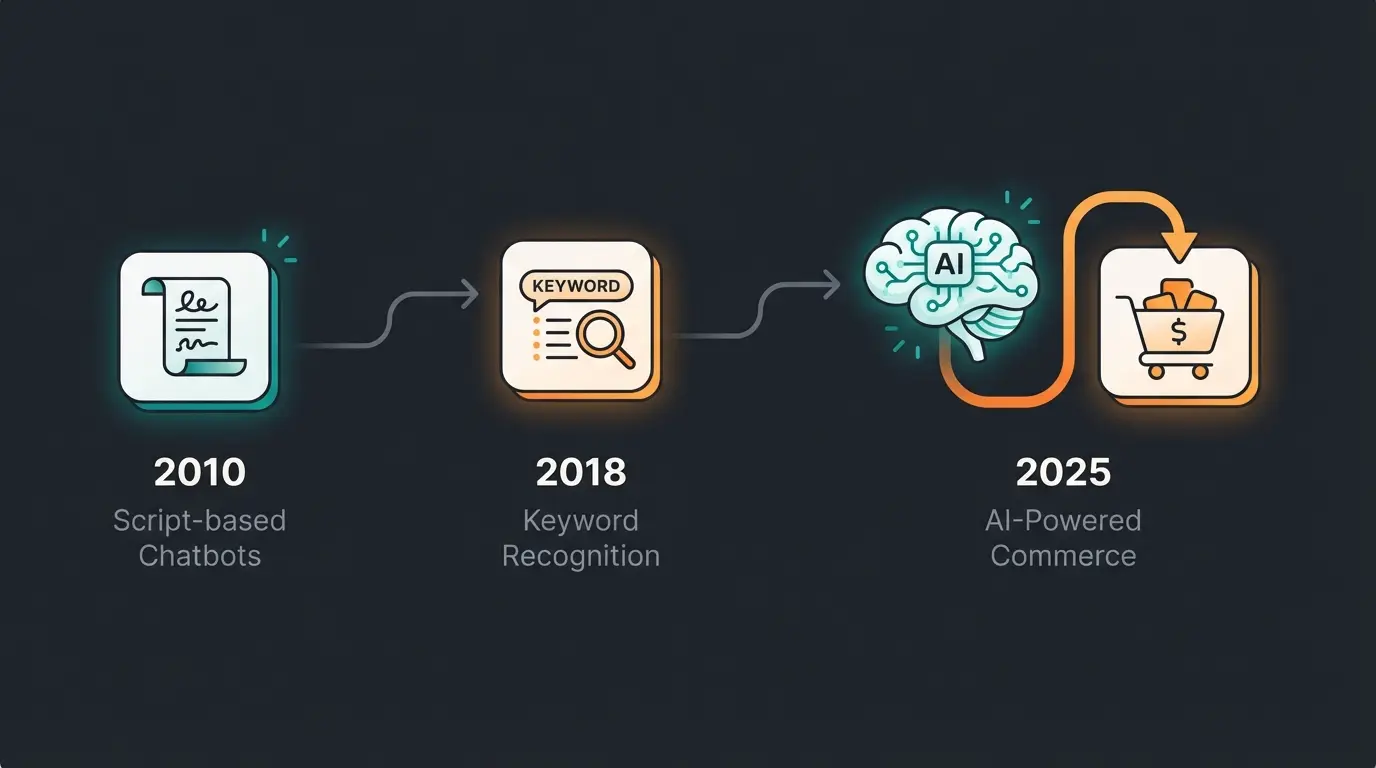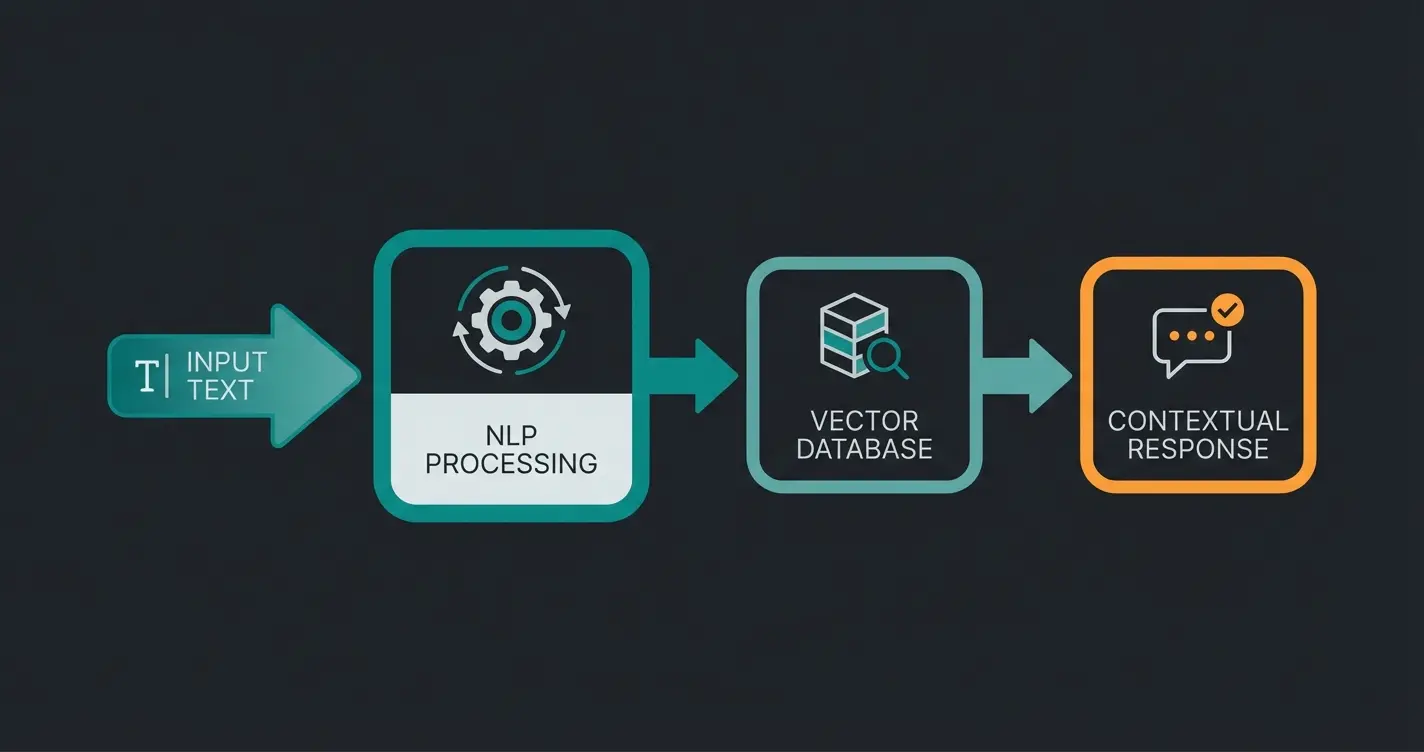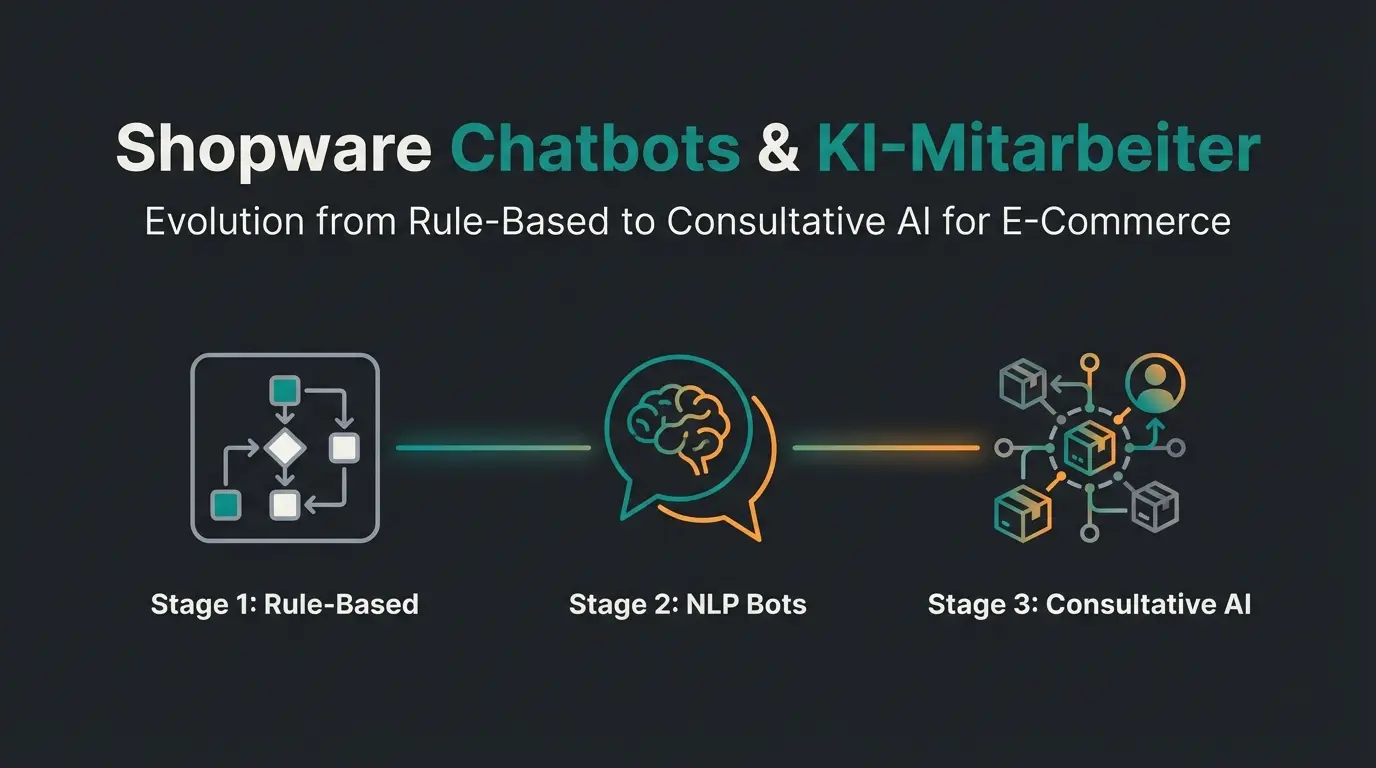AI Chatbots in 2025: From Simple FAQ Bots to Intelligent Product Consultants
Discover how AI chatbots are evolving from support tools to revenue-generating digital sales assistants. Learn about the technology, benefits, and implementation strategies.
Introduction
AI chatbots have developed into an indispensable component of modern corporate communication in recent years. As intelligent virtual assistants, they enable efficient and personalized interaction with customers around the clock. According to a recent study, 84% of companies believe that AI chatbots are becoming increasingly important for customer communication.
However, AI chatbots are far more than simple dialogue systems. As part of comprehensive Conversational AI platforms, they form the backbone of a holistic strategy for automated communication. They integrate state-of-the-art technologies such as machine learning and natural language processing to conduct human-like conversations and handle complex tasks.
In this article, we highlight the central role of AI chatbots in Conversational AI platforms. We explain how they work, demonstrate application possibilities, and discuss opportunities and challenges for companies. We will specifically address the shift from reactive support to proactive Guided Selling, covering:
- Definition: What exactly are AI chatbots and how do they differ from rule-based systems?
- The Gamechanger: How AI acts as a digital product consultant to increase revenue.
- Technology: Which AI technologies (NLP, Vector DBs) are used?
- Integration: How are chatbots integrated into Conversational AI platforms?
- Benefits: What opportunities arise for companies beyond just saving time?
- Challenges: How to master hurdles like hallucinations and GDPR.

What are AI Chatbots?
Definition and Differentiation from Rule-Based Chatbots
AI chatbots are computer-supported dialogue systems that can conduct natural conversations with humans using artificial intelligence. Unlike rule-based chatbots, which are based on predefined decision trees (if/then logic), AI chatbots use machine learning and natural language processing to understand user queries and generate appropriate answers.
While rule-based chatbots can only react to specific keywords, AI chatbots are capable of grasping the context and intention of a message. They can learn from interactions and continuously improve their answers. This flexibility allows them to react appropriately even to unexpected or complex inquiries.
| Feature | Rule-Based Chatbot (Old) | AI Chatbot (New) |
|---|---|---|
| Understanding | Matches specific keywords only | Understands intent and context (NLP) |
| Flexibility | Rigid, breaks if user goes off-script | Adaptive, handles unstructured queries |
| Capability | Simple FAQs and routing | Complex product consultation & reasoning |
| Improvement | Manual updates required | Continuous learning from data |
Why Now? The Shift to Generative AI
The history of chatbots dates back to the 1960s with ELIZA, but the real revolution is happening right now. With the advent of Large Language Models (LLMs) and Generative AI in 2024 and 2025, the capabilities of these systems have exploded. Previously, bots were frustrating barriers; today, they are capable of nuance, empathy, and logic.
Today, AI chatbots are widely used. According to current statistics, 80% of people have already interacted with a chatbot. There are over 300,000 chatbots in use on Facebook Messenger alone. These numbers underscore the rapid spread of the technology in recent years, driven by the massive leap in quality provided by modern AI.
Core Functions of Modern AI Chatbots
Modern AI chatbots are characterized by a range of powerful functions:
- Natural Language Processing (NLP): Understanding and generating human-like language.
- Context Understanding: Grasping the context of the conversation over multiple messages.
- Personalization: Adapting communication to individual users.
- Multilingualism: Support for various languages and dialects.
- Omnichannel Capability: Seamless integration into various communication channels.
- Analytics: Evaluation of conversation data for continuous improvement.
These functions allow AI chatbots to go far beyond simple question-answer scenarios. They can support complex tasks such as product advice, troubleshooting, or even creative processes. An example of this is AI-supported product consultation, which provides personalized recommendations based on individual customer needs.
Technological Foundations of AI Chatbots
AI chatbots form an essential part of modern Conversational AI platforms. To understand how they work, we must look at the technological foundations that drive these intelligent systems.
Machine Learning and Deep Learning
The foundation of advanced AI chatbots is machine learning, specifically Deep Learning. These technologies allow chatbots to learn from large amounts of data and continuously improve their performance. Deep Learning uses artificial neural networks, modeled after the human brain, to recognize complex patterns in data.
A key element for the efficiency of AI chatbots is the use of vector databases. These special databases allow semantic relationships between words and concepts to be stored and retrieved at lightning speed. This improves the chatbot's ability to understand the context of user queries and generate relevant answers, ensuring the AI relies on your specific company data rather than general internet knowledge.
Natural Language Processing (NLP)
Natural Language Processing is another core component of AI chatbots. NLP enables systems to understand, interpret, and generate human language. This involves several steps:
- Tokenization: Breaking sentences down into individual words or phrases.
- Part-of-Speech Tagging: Identifying parts of speech like nouns, verbs, adjectives.
- Named Entity Recognition: Recognizing proper names, places, organizations, etc.
- Sentiment Analysis: Determining the emotional coloring of a statement.
Advanced NLP models like GPT (Generative Pre-trained Transformer) have significantly improved the capabilities of AI chatbots. They enable systems to generate context-related and natural-sounding answers.
Dialog Management and Context Understanding
A powerful dialog management system is crucial for the effectiveness of AI chatbots. It controls the flow of conversation and ensures that the chatbot maintains context over multiple interactions. This includes:
- State Tracking: Storing relevant information from previous interactions.
- Intent Recognition: Identifying the user's goal or intention.
- Context Management: Considering conversation context when generating answers.

The Gamechanger: AI as a Digital Product Consultant
The most significant strategic opportunity for AI chatbots in 2025 is not just answering support tickets—it is selling. This is where Guided Selling comes into play.
Traditional bots fail at sales because they cannot advise; they can only recite. If a user asks, "Which ski fits my riding style?", a rule-based bot fails. An AI Product Consultant, however, mimics a top salesperson. It asks clarifying questions like, "Where do you usually ski?" or "What is your experience level?" to narrow down the catalog and present the perfect product match. This shift transforms the chatbot from a cost center into a profit center.
User expresses a vague need (e.g., 'I need a laptop').
AI asks targeted questions (e.g., 'Gaming or Office work?').
AI suggests specific products from the PIM with reasoning.
User adds the correct item to the cart, reducing return rates.
Don't just answer questions—guide your customers to the right purchase with AI-powered consultation.
See Guided Selling DemoIntegration of AI Chatbots into Conversational AI Platforms
The successful integration of AI chatbots into Conversational AI platforms requires careful planning and implementation. This integration enables companies to optimize their customer communication and offer a seamless omnichannel experience.
Synergies Between Chatbots and Other Communication Channels
AI chatbots can work seamlessly with other communication channels to offer a holistic customer experience. For example, a WhatsApp bot can be used in the e-commerce sector to answer product inquiries and support purchasing processes directly within the messaging app users love most.
Integration enables intelligent routing of customer inquiries. Simple requests can be handled by the chatbot, while more complex cases are forwarded to human employees. This leads to more efficient resource utilization and improved customer satisfaction.
Data Integration and Analysis
A crucial aspect of integrating AI chatbots is data integration. Chatbots must have access to relevant company data to provide precise and helpful answers. This can include product information (PIM), customer data (CRM), or service information.
At the same time, AI chatbots generate valuable data about customer interactions. This data can be analyzed to:
- Understand Customer Behavior: Gain deeper insights into customer needs and preferences.
- Optimize Processes: Identify weaknesses in business processes.
- Improve Products: Collect feedback for product development.
Areas of Application for Companies
1. Guided Selling (Product Consultation)
In the e-commerce sector, AI chatbots support customers in product selection and provide personalized recommendations. They can answer questions about product features, help with size selection, and accompany the purchasing process. AI-supported advisory systems analyze customer behavior and offer tailored suggestions that can significantly increase the conversion rate.
2. Customer Service and Support
In customer service, AI chatbots have proven particularly effective. They can process a multitude of customer inquiries quickly and efficiently without human intervention. AI-supported systems can answer standard queries, solve problems, and assist customers with simple processes. This leads to shorter waiting times and higher customer satisfaction.
3. Internal Corporate Communication
AI chatbots also find application in internal company communication. They can assist employees in searching for information, help with managing leave requests, or serve as virtual assistants for various internal processes. This increases efficiency and relieves HR departments.
4. Specialized Industries (Healthcare & Finance)
In the healthcare sector, AI chatbots assist patients with symptom analysis or appointment scheduling. In banking, they help customers with routine tasks like balance inquiries or transfers. However, in these sensitive industries, the accuracy of the AI is paramount to avoid liability.
Challenges and Solutions: Trust & Data Privacy
While the benefits are clear, integrating AI chatbots involves navigating specific challenges, particularly regarding trust and data security.
Hallucinations vs. Accuracy
A common fear is that the AI might "hallucinate" (invent facts). For a product consultant, inventing a feature that doesn't exist is a disaster. The solution lies in Retrieval-Augmented Generation (RAG). This ensures the AI is strictly bound to your uploaded product catalog and cannot answer outside of the provided context.
GDPR and Data Protection (DSGVO)
Handling sensitive customer data requires special care and strict adherence to data protection guidelines, especially in the EU. Generic US-based chatbots often fail here. It is critical to choose a provider that hosts data in Europe and is fully GDPR compliant, ensuring that customer data is processed securely and transparently.
Best Practices for Implementation
To unlock the full potential of AI chatbots, careful implementation is essential. Here are the most important best practices:
Strategic Planning and Goal Setting
The first step is thorough strategic planning. Define clear goals for your chatbot, such as improving customer service, increasing sales, or relieving the support team. According to studies, 84% of companies believe AI chatbots are becoming increasingly important. Align your strategy with overarching business goals and set measurable KPIs.
Design and UX
A well-designed interface is crucial for acceptance. Studies show that 69% of consumers were satisfied with their last chatbot interaction when the experience was intuitive. Ensure the bot is transparent about being an AI and offers a seamless handover to human agents when complex issues arise.
Training and Continuous Improvement
Training your AI is an ongoing process. Use machine learning to let the chatbot learn from interactions. For instance, the Neudorff AI product advisor achieved an impressive 97% accuracy in product recommendations through rigorous training and feedback loops.
Conclusion: The Future of Customer Interaction
The integration of AI chatbots into Conversational AI platforms offers companies the opportunity to revolutionize their customer interactions. By combining advanced AI technology with existing communication channels, companies can offer personalized, efficient, and scalable customer service. More importantly, they can transform support costs into sales revenue through intelligent product consultation.
As shown by the example of WhatsApp bots in e-commerce, these technologies offer significant competitive advantages. Industry studies suggest chatbots can save up to $0.70 per customer interaction. However, the real value lies in the increased basket sizes and conversion rates delivered by a true digital sales assistant.
Standard chatbots follow rigid 'if/then' rules and fail if a user uses unexpected phrasing. AI chatbots use NLP to understand context and intent, allowing for natural, flexible conversations.
Yes. Through 'Guided Selling,' AI chatbots act as digital sales assistants. They ask clarifying questions to understand customer needs and recommend the perfect product from your catalog, significantly boosting conversion rates.
It depends on the provider. For the German market, it is essential to use a solution that is GDPR (DSGVO) compliant, hosts data in the EU, and does not use customer data to train public models.
With modern no-code platforms, a basic AI chatbot can be live in days. A fully integrated Product Consultant linked to your PIM system typically takes a few weeks to fine-tune for maximum accuracy.
Stop losing customers to unanswered questions. Implement a GDPR-compliant AI Sales Assistant today.
Start Your Free Trial
